Admin
February 23, 2022
Wastewater is laden with valuable community data

Our wastewater data holds valuable insights that signals when a community is sick, sad, or polluting. It also offers important signs for when life is getting better
In recent years, technology has improved enough to allow wastewater engineers to perform an even more valuable public service, testing and evaluating wastewater for community and environmental insights.
Hormones & Pharmaceuticals in Wastewater
Around the world, wastewater is being tested for changing levels of human hormones and pharmaceuticals. Rising levels of the female hormone estrogen, linked to birth control pills, have been linked to sex changes in some fish species downstream from hormone-laden wastewater discharges.
Though estrogen has been found to naturally degrade in the wild, biologists still voice concerns about the long-term consequences on aquatic environments. Removing estrogen from urban wastewater streams would cost taxpayers many millions. But it is there in growing quantities and knowing that is an important start.
Medicines are another emerging issue. When doctors prescribe pharmaceuticals, they are thinking of the patient’s immediate health, but many of those same drugs can end up passing through wastewater plants.
Though more than 1,400 pharmaceuticals have been approved by the FDA for sale, few are being treated at wastewater plants, and the consequence on fish and other aquatic populations is mostly a mystery.
According to the Water Science Center of the US Geological Survey, “Acute ecotoxicity data are available for only a small portion of these compounds, and chronic toxicity data are even scarcer. In addition, little is known about the ultimate environmental fate of most pharmaceuticals. These knowledge gaps prevent a full understanding of the effects of pharmaceuticals, if any, on non-target organisms in the environment.”
Putting technology to work to identify these chemicals and remove them from the wastewater, or even reduce their emissions from the source, should be an imperative for our policymakers and the public at large.

Impact of Microbeads on Oceans & Rivers
A similar problem exists with microbeads, a new technology that adds tiny plastics to cosmetics and cleaning products. Some consumers may apply microbeads to their skin without knowing the ultimate consequence on ocean and river life. Greenpeace has called microbeads “toxic time bombs.”
As much as 2 million tons of plastic microbeads now pollute the world’s oceans and contaminate the world’s fish. Microbeads are difficult and expensive for engineers to remove from wastewater.
The broader issue with hormones, pharmaceuticals, and microbeads is that we all should be more cognizant of what we are dumping into our sewage system and more determined to remove them from our wastewater.
Benefits of Wastewater Testing & Tracking Technology
Modern wastewater testing technology is continuously getting better at detecting and tracing dangerous pollutants in our wastewater. Wastewater engineers can play an important role in helping regulators identify the companies responsible for these hot loads.
Companies themselves also can benefit from waste-tracking. High loads of pollutants in wastewater often are a sign of inefficient industrial processes. A company flagged for discharging contaminated wastewater can learn from its mistake and improve its operations.
Tracking COVID-19 in Wastewater
As far as health monitoring is concerned, the most recent — and perhaps most valuable — example of new wastewater technology has come during the COVID-19 pandemic. Doctors and scientists have monitored wastewater flows to detect the rise and fall of the virus in numerous cities around the world.
COVID detection tests in wastewater have helped communities prepare hospitals for an expected surge of patients. They have also warned public health officials when extra community protection measures might be warranted.
“Depending on the frequency of testing, sewage surveillance can be a leading indicator of changes in COVID-19 burden in a community,” reported the U.S. Centers for Disease Control.
With new technologies for wastewater treatment, dangerous pollutants in the water supply can be detected early and addressed, making this precious — and exhaustible — resource safe for reuse in our lakes and oceans, on our farms, and for human consumption as drinking water. We owe it to our environment and each other to do nothing less.
*Republished from: WWD Magzine
For more information feel free to download our WBE one pager or read more about our solution. Do you have any additional questions?
Please reach out to | Anne-li@kando.eco
Your wastewater contains the data.
We just need to extract it so that you can optimize your operations.
Contact us and a member of our team will get back to you as soon as possible.




